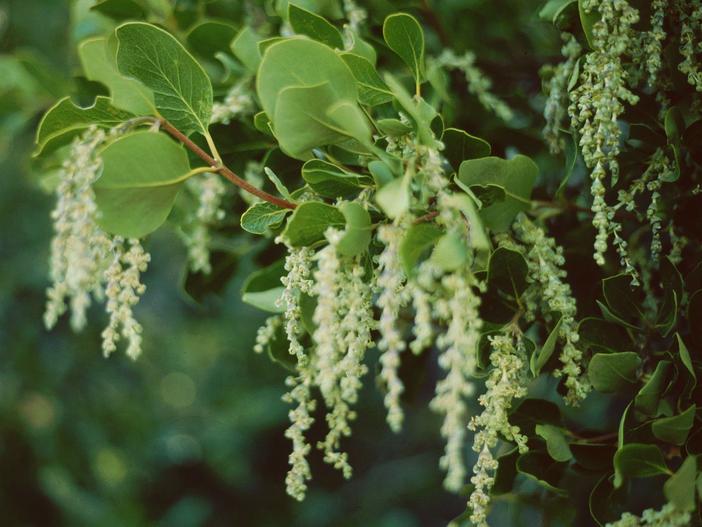Bearbrush
(Garrya fremontii)
Bearbrush (Garrya fremontii)
/
/

Franz Xaver
CC BY-SA 3.0
Image By:
Franz Xaver
Recorded By:
Copyright:
CC BY-SA 3.0
Copyright Notice:
Photo by: Franz Xaver | License Type: CC BY-SA 3.0 | License URL: https://creativecommons.org/licenses/by-sa/3.0 | Uploader: Franz Xaver | Publisher: Wikipedia Commons














Estimated Native Range
Summary
Garrya fremontii, commonly known as Bearbrush, is an evergreen shrub native to the chaparral and mixed evergreen forests of California and the Pacific Northwest. It typically grows to a height of three to four meters and is well-adapted to its native dry, rocky habitats. Bearbrush has a dense, rounded form with oval-shaped, smooth green leaves that are 2 to 12 centimeters long and about half as wide, sometimes with hairs on the undersides. The plant is dioecious, meaning individual plants are either male or female. Male plants produce long, hanging clusters of yellowish to pinkish flowers, while female plants bear spherical berries that transition from green to pink and then to purple as they mature. These berries are an important food source for birds and mammals, which aid in seed dispersal. Bearbrush is also capable of resprouting from its root crown after disturbances such as wildfire.
Bearbrush is valued for its drought tolerance and wildlife support in cultivation. It is often used in native plant gardens, as a screen or hedge, and in restoration projects. This shrub thrives in full sun to part shade and is adaptable to a range of soil types, provided they have good drainage. While it can survive with low water once established, moderate watering will support more vigorous growth. Bearbrush is relatively low-maintenance, but gardeners should be aware that it can become leggy if not pruned regularly. It is also resistant to most pests and diseases, making it a hardy choice for challenging sites.CC BY-SA 4.0
Bearbrush is valued for its drought tolerance and wildlife support in cultivation. It is often used in native plant gardens, as a screen or hedge, and in restoration projects. This shrub thrives in full sun to part shade and is adaptable to a range of soil types, provided they have good drainage. While it can survive with low water once established, moderate watering will support more vigorous growth. Bearbrush is relatively low-maintenance, but gardeners should be aware that it can become leggy if not pruned regularly. It is also resistant to most pests and diseases, making it a hardy choice for challenging sites.CC BY-SA 4.0
Plant Description
- Plant Type: Tree, Shrub
- Height: 6-9 feet
- Width: 3-6 feet
- Growth Rate: Moderate
- Flower Color: Cream, White
- Flowering Season: Winter, Spring
- Leaf Retention: Evergreen
Growth Requirements
- Sun: Full Sun, Part Shade
- Water: Low, Medium
- Drainage: Slow, Medium, Fast
Common Uses
Bee Garden, Bird Garden, Butterfly Garden, Deer Resistant, Drought Tolerant, Low Maintenance
Natural Habitat
Native to chaparral and mixed evergreen forests
Other Names
Common Names: California Fever Bush, Frémont’s Silktassel
Scientific Names: , Garrya fremontii, Garrya rigida, Garrya fremontii var. laxa,
GBIF Accepted Name: Garrya fremontii Torr.